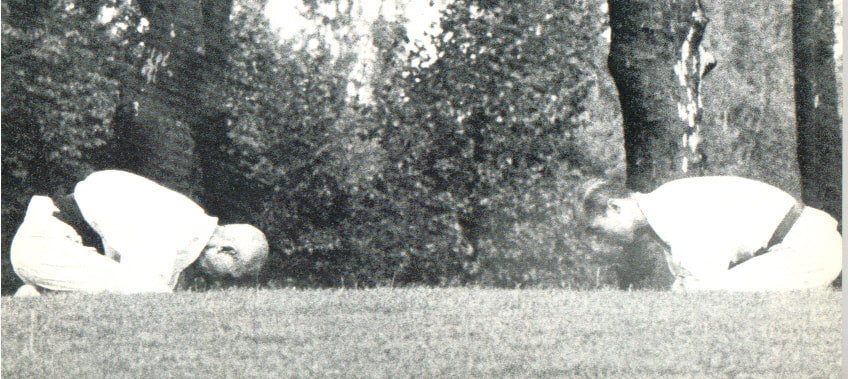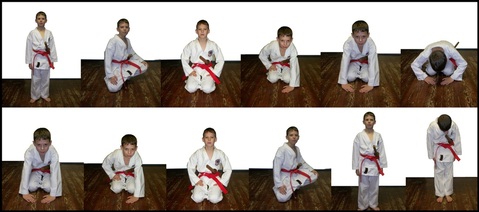Bowing in the Dojo
Certain cultures and religious-superstitions may restrict participation in traditional Japanese Wadoryu Karate, due to the traditional respectful bowing procedures, etiquette and ceremonies required. All participants are required to bow within the Dojo environment; please consider this before training within a British Wadokai Karate Dojo.
Is Rei (the bow) Religious?
The answer to that is simply a difference between ‘respect’ and ‘worship’. In Karate there IS NO worship, just mutual respect; so there would be NO conflict with any religious ideals or beliefs.
In Japan bowing is also a common way of saying thank you, please, in offering something, when one apologises or even requests something, etc. But if the greeting takes place inside on a tatami floor, the Japanese would often get down on their knees to bow to each other and show correct respect upon entering.
These are some of the reasons why Japanese bow in Japanese society.
The Japanese bow when they greet people, as their sign of respect and in regard to each other. As a Japanese child reaches past school age, he or she must know that there are various types of bowing or showing respect. A small bow or nod may be used only in an informal or casual manner, between friends and even family members. All ‘correct’ bowing must be done from the hip and not simply from the neck. However, many Japanese understand that most foreigners do not know how to bow correctly, so may sometimes accept an informal-bow from a foreigner to a formal-bow when first meeting (but remember that many Japanese may still take offence to a simple ‘nod’ from the neck).
The lower bow is what is referred to as the ‘usual-bow’, which is when one acknowledges someone to be of higher position or social status and this indicates respect (the angle of this bow can be anything between 30 and 45 degrees, depending on the circumstances).
In Japanese martial-arts we see the bow used in a similar way as for Japanese business and social interactions rather than religious ones. In this respect, it is associated more to a Western handshake rather than to any unconnected Asian religion. However, when we enter the Dojo we bow as a sign of respect for the dojo training environment and for the occupants (many students may also bow in return if you’re seen to enter). We bow to our higher graded instructors, again, as a sign of mutual respect.
Bowing is an integral part of any traditional Japanese martial-arts. Bows are used to begin and end practice, sparring bouts in kumite & competition, and when entering and leaving the Dojo, or training-room.
Some non-Japanese martial-arts bows are different in terms of the position of the arms and hands, etc. For example, a Japanese karate bow is performed with the arms at the sides, while other martial-arts bows, such as in Tai-boxing and some Chinese martial-arts, are often performed with the hands together and hands and arms in front.
In effect, you are thanking your opponent for giving you the opportunity to improve your technique”
Jigaro Kano
Being involved in a Japanese martial-art the bow is of equal importance within the Dojo, and must be understood and performed by all practitioners in the correct way. All Japanese martial-arts use the Rei within the Dojo environment, there are no exceptions.
A student must always bow to the Sensei when he is being addressed and when he has finished being addressed. A bow must be performed before and at the end of each fighting routine or other partner-work encounter there must be a Tachi-rei between performers at the relevant and appropriate times, even when there are no commands to do so. On the command of ‘Rei’ and or ‘Tachi-rei’ all students must perform the standing-bow instantly.
When to perform a standing-bow: As a sign of respect to the occupants and Dojo, the bow should be done on every entry and exit made, directed towards the Shomen of the Dojo from doorway entrance.
The bow MUST be performed when addressing a Sensei or a higher grade and each performer must direct his view towards those who are performing the rei to you. Keep your view forward during the tachi-rei, this way your gaze is upon your partner and/or opponent.
The ‘kneeling-bow’, at the start and the end of the training session, symbolises the following:
The 1st Za-rei (kneeling-bow) is to the Shomen-ni-rei; a bow to those who have come before us (there is usually a picture of our past teachers displayed at the front). We bow towards the front of the Dojo in respect to our past teachers and their guidance over the years.
The 2nd Za-rei is Sensei-ni-rei; teacher and students bowing to each other and respecting each other for their presence. We are demonstrating mutual respect for each other.
The 3rd Za-rei is Otaga-ni-rei; students symbolically bowing to each other.
If you are physically incapacitated or temporarily injured, the standing bow may replace the formal O-Rei at the start and the end of the training session. However, the student MUST move well away from the ranks, to the rear of the class, to perform the Tachi-rei and then re-join the class, into the ranks, when O-Rei has been completed. This action must be done formally with quick movement and not performed sloppily or disrespectfully.
In the Dojo it is good etiquette and respect to bow where and when necessary. Students who refuse to bow correctly within the Dojo environment may be asked to leave, as they may be considered demonstrating disrespect within the Dojo environment and to those around them.
Is your ‘intention’ for bowing correct for the Dojo? If we all wish to learn correct traditional Wadoryu Karate we must all learn the mutual traditional respectful values within our art. All traditional oriental martial-arts have either a bow, or some form of mutual salutation, related to the source of their art; traditional Wadoryu Karate is no exception and there will be no compromise.
THERE IS NO EXCUSE FOR NOT BOWING CORRECTLY WITHIN THE DOJO – Your future progression within British Wadokai may depend on it!


